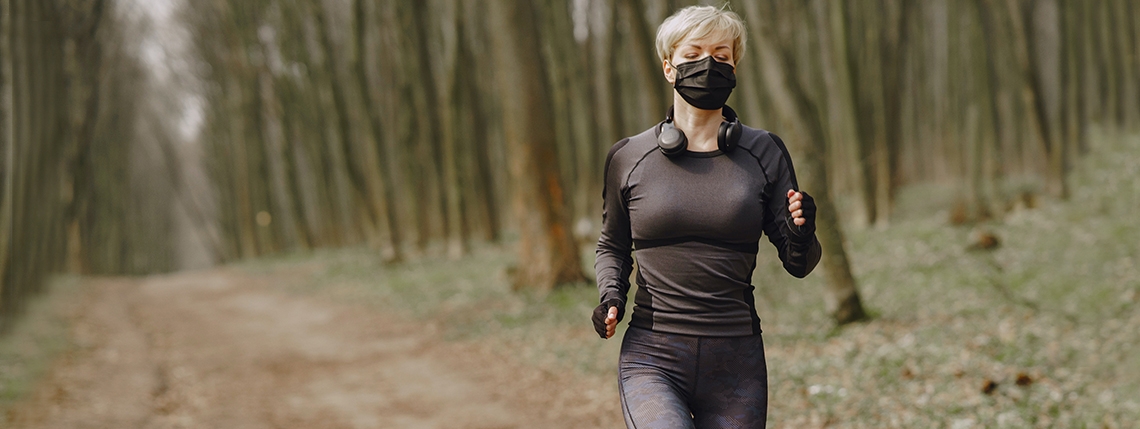There’s confusion over guidelines but should fit pros wear face masks and encourage clients and gym members to wear them? What are the guidelines and what’s the evidence to support covering up to prevent against the virus?
When it comes to face masks and coverings, it would be fair to rename coronavirus confusion virus. Since the start of the pandemic, there’s been conflicting evidence and messaging from scientists and politicians and inconsistent practices in businesses. However, as of 13 July, Boris Johnson has said that face coverings will be mandatory in shops and supermarkets from 24 July.
The fitness industry breathed a sigh of relief when it was announced that gyms are set to reopen on 25 July. But the guidelines regarding face coverings remain blurred. According to the government guidelines published at gov.uk, “Workplaces should not encourage the precautionary use of extra PPE to protect against COVID-19 outside clinical settings.” In addition, the government guidelines say, “All forms of face coverings may restrict breathing efficiency and should not be used during exercise except on specific advice from a physician.”
Guidance on 16 June 2020 from the World Health Organization (WHO) says that people shouldn’t wear face masks while exercising because it could reduce the ability to breathe comfortably. This, according to some experts, is particularly relevant if you suffer from asthma, chronic obstructive pulmonary disorder (COPD), bronchitis, cystic fibrosis, pulmonary fibrosis and any other conditions that affect the heart or lungs. In addition, if you have a cardiovascular or respiratory condition, it’s a good idea to ask your doctor about exercising with a face mask before attempting to do it.
But many are asking if exercising is a riskier activity in terms of spreading the virus? Are masks needed more when we exercise and as we produce more sweat and can spray droplets further? According to some experts, the answer is simply ‘no’. Dr Ben Killingley, consultant in acute medicine and infectious diseases at University College London Hospital, told The Daily Telegraph in July, “No reason comes to my mind that we should be recommending face masks to be used during exercise. It would be expected that people should be socially distanced during exercise.”
However, there does seem to be compelling evidence for wearing masks day to day when we look at the global picture. In Japan, wearing a face mask is culturally acceptable, and expected, to prevent not just coronavirus but all viruses, including flu and hayfever. According to the NY Times, Japan has reported more than 17,000 infections and just over 900 deaths, while the United States, with a population roughly two and a half times as large, is approaching 1.9 million cases and 110,000 deaths and some are suggesting this is down to their use of masks. Despite these stats you will also find evidence to say masks don’t work; however, according to the University of California looking at the US messaging, there’s a reason for confusion: “Both the Centers for Disease Control and Prevention (CDC) and WHO now recommend cloth masks for the general public but, earlier in the pandemic, both organisations recommended just the opposite. These shifting guidelines may have sowed confusion among the public about the utility of masks.”
At the time of writing, the decision remains a choice when it comes to the fitness environment. As a fitness professional, do you need to take extra care? If, for example, you teach a class of six and teach five classes, you could be in close contact with 30 people a day. One area where there’s less argument about what’s safe and what’s not is around social distancing, so as an instructor it makes sense for you to be rigorous about ensuring social distancing is practised (we suggest you add in reminders in your verbal teaching cues). But, with so much uncertainty and very little research, is it just easier to wear a face covering when you teach and offer clients the choice?
If your answer is yes and you choose to wear a mask, there are a number of brands working for your needs, including Under Armour, Adidas and Reebok who have all designed non-medically graded masks for exercising, and they are reportedly selling well. Features of the masks include ‘heat-dispersing anti-microbial fabrics’ (Under Armour) and they are all washable and reuseable. Many other companies are in on the act and, as businesses invest in masks, it could be argued that there’ll be an influential lobby to ensure we wear them.
In this era of uncertainty, many trainers are choosing to err on the side of caution and wear masks themselves and suggest to clients to wear them. Trainers can suggest to clients that, if they find the mask uncomfortable and if they feel their breathing is restricted, they can take it off; however, it’s vital that they keep their distance. Our advice is to keep checking the government guidelines online. Insurance continues to operate in line with the government guidelines, so instructors should continue to check for further updates. For reference, the current guidelines for face coverings are as follows.







